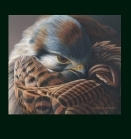
Originals
Reproductions
Merchandise
|
| Home | Main | Links | Site Map | Gallery |
About David N. Kitler Reproductions
These prints are reproductions of a David N. Kitler original piece and represent a more affordable way for you to enjoy his images in your home or office. Great care is taken to ensure their quality. Following is some information on the terms often used to describe prints.
Lithographs vs. Giclées
David N. Kitler's lithographs are museum quality reproductions printed on an offset printing press. These lithographs are printed on acid-free archival paper, using four to eight colour separations. Until recently, when talking about traditional prints, most artists and collectors were referring to lithographs.
A giclée is a print that results from a digital printing process. The word is taken from the French, meaning "to spray." In this process, after an image is scanned to a digital format, it is printed on a high-quality wide-format ink-jet printer (not to be confused with the desktop printers found in most home offices today...) In this case, millions of droplets are sprayed each second directly onto the print surface (paper or canvas), resulting in a smooth and consistent image, which is almost as vibrant as the original piece. Each giclée in the edition is created one at a time, unlike mass-production printing methods that use offset presses. Because they are made one at a time, editions are produced in very small quantities and each giclée has its own unique characteristics. Due to the nature of the materials used, no two giclées in an edition are exactly alike.
Giclée prints may give you many more years of enjoyment than their lithograph counterparts. However, that only holds true if the right combination of printing equipment, inks, and substrates is secured. If you are considering purchasing a giclée, check with Wilhelm Imaging Research, Inc. for independent test results on the different combinations. David N. Kitler's giclées on paper use combinations that are rated to last 100+ years before any noticeable fading occurs.
Limited vs. Open Editions
A limited edition print is one in which the maximum number of prints in the edition is fixed up front (e.g. 270). David signs and sequentially numbers each print using a pencil. The number appears on the lower left corner as "print number / total prints in the edition" (e.g. 1/270) and the signature is placed on the lower right corner. Once all the prints in the edition are sold, the edition is closed and no future ones will be published. All of David N. Kitler's limited edition prints are accompanied by a "Certificate of Authenticity," which itemizes the number of prints in the edition.
Open edition prints are those in which no maximum number of prints has been set. Individual prints may or may not be signed by the artist, but they are not numbered. Despite the fact that David's open editions are printed using the same quality standards as his limited editions, their "unlimited" nature usually translates into lower retail prices.
Care
All artwork should be placed out of direct sunlight. Paper prints (lithographs as well as giclées) should be framed behind glass, and be matted and finished using only acid-free materials. The use of inferior products may damage the prints, as the acidity could interact with the image's paper and inks. David's giclée canvas prints do not need to be framed behind glass, as they have received a protective coating. With proper care, your David N. Kitler print will continue to bring you enjoyment for many decades.